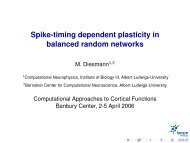Combined Analog/digital signaling in local cortical networks
Combined Analog/digital signaling in local cortical networks
Combined Analog/digital signaling in local cortical networks
You also want an ePaper? Increase the reach of your titles
YUMPU automatically turns print PDFs into web optimized ePapers that Google loves.
Lab Members<br />
<strong>Comb<strong>in</strong>ed</strong> <strong>Analog</strong>/<strong>digital</strong> <strong>signal<strong>in</strong>g</strong> <strong>in</strong> <strong>local</strong> <strong>cortical</strong> <strong>networks</strong><br />
YouSheng Shu<br />
Andrea Hasenstaub<br />
Yuguo Yu
Action Potentials and Triggered Transmitter Release: The<br />
Workhorse of Information Communication <strong>in</strong> the Bra<strong>in</strong>
Membrane Potential of Cortical Neurons<br />
Varies Widely Dur<strong>in</strong>g Slow Wave Sleep<br />
and Even Dur<strong>in</strong>g Wak<strong>in</strong>g<br />
Figure adapted from Steriade et al, J. Neurophysiol 85:1969, 2001
Spontaneous recurrent <strong>cortical</strong> activity occurs <strong>in</strong> vitro<br />
UP<br />
Down<br />
Interface<br />
Submerged
Subthreshold synaptic potentials travel down axon<br />
dendrites<br />
5 mV<br />
500 ms<br />
soma<br />
axon<br />
50 μm
The Axon Exhibits a Long Length Constant Dur<strong>in</strong>g Synaptic Activity
Models of Complete Axonal Tree Indicate that the Length<br />
Constant of Axons if <strong>in</strong> the Hundreds of Microns
A Significant Portion of the Axonal Tree is with<strong>in</strong> 1 and 2 Length<br />
Constants (approximately 200 synapses <strong>in</strong> 1 and 2000 <strong>in</strong> 2<br />
length constants)
Morphology of the Two<br />
Pyramidal Cells for Which the<br />
Synaptic Physiology was<br />
Exam<strong>in</strong>ed <strong>in</strong> the Next Slide
napi<br />
Membrane Potential of the Presynaptic Soma Affects the Amplitude<br />
of the Average Postsynaptic Potential!
Action-potential free Synaptic<br />
Transmission <strong>in</strong> the Bra<strong>in</strong><br />
Basket Cell<br />
Pre-TTX<br />
TTX<br />
Purk<strong>in</strong>je<br />
Cell<br />
N=7<br />
Glitsch and Marty, J. Neurosci. 19: 511 (1999)
These Results Indicate That the Amplitude of the EPSP Encodes<br />
the Membrane Potential of the Presynaptic Cell.<br />
This Indicates that Information is NOT Encoded Only Through the<br />
Pattern of Action Potentials.<br />
Rather, Information is Encoded as a Mixture of Spike Pattern and<br />
Membrane Potential of the Presynaptic Cell and Network
Critical Po<strong>in</strong>ts to be determ<strong>in</strong>ed:<br />
1) Mechanism (change <strong>in</strong> basal or triggered<br />
presynaptic Ca2+, change <strong>in</strong> axonal action potential<br />
duration, or voltage-dependent changes <strong>in</strong> synaptic<br />
transmission)<br />
2) K<strong>in</strong>etics (evidence for slow and fast components)<br />
3) Voltage Dependence (appears to be l<strong>in</strong>ear <strong>in</strong> the<br />
range of rest to fir<strong>in</strong>g threshold)<br />
Goal: Understand the Functional (Computational)<br />
Consequences of Mixed Transmission on Cortical<br />
and Bra<strong>in</strong> Function
The Modulation of EPSP Amplitude by Presynaptic Somatic Vm<br />
Requires > 1 Second to Fully Develop n and Dissipate. Are there faster<br />
components<br />
Note lack of adaptation with ma<strong>in</strong>ta<strong>in</strong>ed membrane potential
Depolarization-<strong>in</strong>duced facilitation at mossy<br />
fiber synapses shows rapid k<strong>in</strong>etics<br />
Alle and Geiger, Science (2006)
The Presynaptic Facilitatory Effect of Somatic Vm is a Cont<strong>in</strong>uous<br />
Function of Voltage napti
Possible Mechanism 1: Changes <strong>in</strong> AP<br />
duration with membrane potential.<br />
Depolarization slowly <strong>in</strong>creases spike duration<br />
<strong>in</strong> the axon and this is blocked by 4AP
4AP and<br />
Dendrotox<strong>in</strong> Block<br />
the Slowly<br />
Inactivat<strong>in</strong>g K+<br />
current <strong>in</strong> the Axon
Possible Mechanism 2: Changes <strong>in</strong> probability of release by changes <strong>in</strong><br />
synaptic Ca2+<br />
Synaptic transmission at the Calyx of Held is Facilitated by<br />
depolarization though a Ca2+ dependent mechanism<br />
Nature Reviews Neuroscience 3, 53-64 (2002)
Membrane Potential of the<br />
Presynaptic Term<strong>in</strong>al <strong>in</strong> the<br />
Calyx of Held Determ<strong>in</strong>es the<br />
Amplitude of the EPSP Evoked<br />
Slope = 100%/10 mV or 10%/mV<br />
Awatramani, Price, Trussell Neuron 48: 109-121 (2005)
Small Voltage Steps at the Calyx of Held Result <strong>in</strong> Increases <strong>in</strong><br />
Presynaptic Calcium Levels<br />
Awatramani, Price, Trussell Neuron 48: 109-121 (2005)
Two photon Imag<strong>in</strong>g of Presynaptic<br />
Ca2+ <strong>in</strong> Axonal Term<strong>in</strong>als
Group data illustrat<strong>in</strong>g the dependence of<br />
presynaptic Ca2+ levels on somatic<br />
membrane potential
The Facilitatory Effect of Presynaptic Somatic Depolarization on EPSP Amplitude<br />
Between Layer 5 Pyramidal Cells is Blocked by Buffer<strong>in</strong>g of Ca2+<br />
Electrodes Conta<strong>in</strong><strong>in</strong>g 25 micromolar BAPTA: Facilitation <strong>in</strong> 17/26 pairs<br />
Electrodes Conta<strong>in</strong><strong>in</strong>g 1 mM EGTA: Facilitation <strong>in</strong> 3/11 (p=0.01)<br />
Electrodes Conta<strong>in</strong><strong>in</strong>g 10 mM EGTA: Facilitation <strong>in</strong> only 1/16 pairs (p
Conclusions:<br />
Local Information Transmission <strong>in</strong> the Cerebral Cortex (and other bra<strong>in</strong> areas) may occur<br />
through a mix of “graded” and “triggered” or analog and <strong>digital</strong> modes.<br />
The mechanisms of this mixed communication may <strong>in</strong>volve:<br />
Variations <strong>in</strong> axonal action potential duration<br />
Variations <strong>in</strong> presynaptic Ca2+ levels<br />
Voltage dependent changes <strong>in</strong> release probability<br />
The use of a comb<strong>in</strong>ed “analog/<strong>digital</strong>” mode of synaptic transmission may <strong>in</strong>crease<br />
the efficiency of <strong>in</strong>formation cod<strong>in</strong>g <strong>in</strong> the bra<strong>in</strong> and may be important <strong>in</strong> the<br />
operation of neuronal assemblies. The mechanisms and implications rema<strong>in</strong> to be<br />
determ<strong>in</strong>ed.








